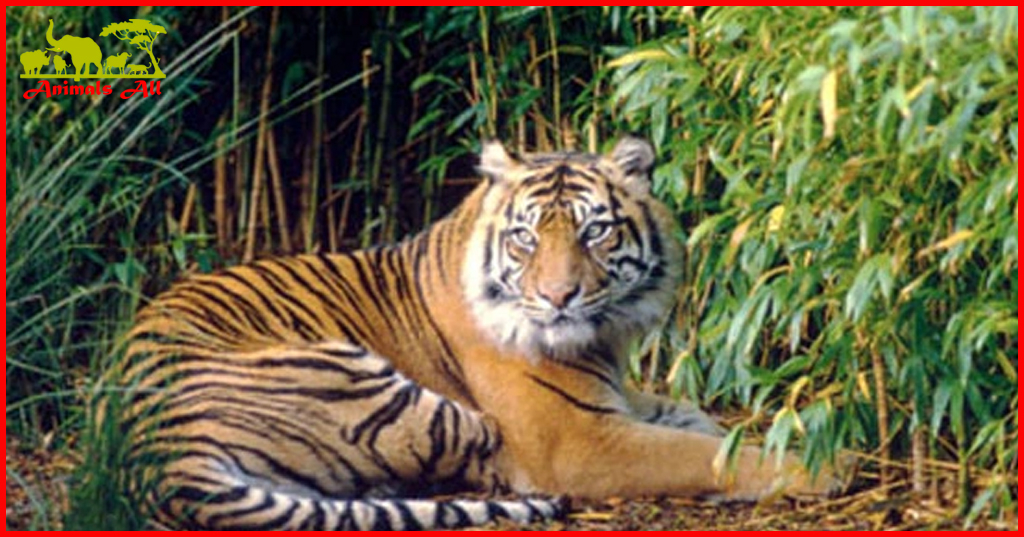
Sumatran Tiger, The king of zoo
The Sumatran tiger is a carnivorous animal of the family Felidae. Its small size allows it to move quickly through dense forests. It has dark orange fur with dense stripes. The black stripes are wide, with a small distance between them, and they are often arranged in pairs; there are stripes on the front legs, and the cheek hair on the face is relatively long; the whiskers are also long, and the hair on the whole body is relatively dense; Female tigers are smaller in length and weight than males.
Sumatran tigers
Sumatran tigers live primarily in tropical rainforests within the Sumatran archipelago, with their range determined by prey density and habitat size. The habitat ranges from plain forests to high mountains. They hide during the day and come out to forage at night. Itsmain food is sambar deer, wild boar, porcupine, crocodile, python, young rhinoceros and young elephant. In the rainforest, the Sumatran tiger mainly relies on ambush and attack prey. Mating can occur all year round, with late winter and early spring being the most frequent mating times; The gestation period of a female tiger is about 103 days, and each litter contains 2 to 4 cubs. The maximum lifespan in the wild is 15 years, and in captivity it is 20 years.
The Sumatran tiger is the smallest of the living tiger subspecies. Due to human invasion and destructive exploitation of natural resources, the habitat of the Sumatran tiger has been continuously reduced and cut into pieces. The Asia Pulp and Paper Corporation set up a factory on the island of Sumatra, which led to a large amount of deforestation. The destruction of the forest caused a large loss of the Sumatran tiger’s habitat. Second, overhunting has put them on the verge of extinction. Tiger hunting has long been rampant in Sumatra, and the rapid increase in the number of people migrating to Sumatra has further intensified the conflict between humans and tigers. The Sumatran tiger is classified as Critically Endangered (CR) on the IUCN Red List of Threatened Species. There are approximately 400–500 Sumatran tigers left in the wild.

History of Species
The Sumatran tiger is one of the subspecies of tiger. The ancestors of the Sumatran tiger originated from the continental tigers in the early and middle Pleistocene. The sea level rose 12,000 years ago, isolating the Sumatra region from the Asian continent. Tens of thousands of wild tigers were separated to form a significantly different new subspecies – Panthera tigris sumatrae (Sumatran subspecies). It was named and established in 1929 by Pocock, a famous theriologist at the Natural History Museum in London, England.
At the end of 2004, Huang Ji (Shanghai Natural History Museum, member of the American Theriological Society) collaborated with world-renowned theriologist Professor Colin P. Groves (Australian National University) on a research project on Sumatran tigers. The study showed that its differentiation has reached the species level, belonging to the island tiger (Isiand group), and represents a branch of modern tiger evolution. The paper was published in Germany
Morphological characteristics
The Sumatran tiger is the smallest of all existing tiger subspecies. The average length (from head to tail) of a male Sumatran tiger is 234 cm and the average weight is 120 kg, while the average length of a female is 198 cm and the average weight is 90 kg. Its stripes are narrower than those of other tiger subspecies, and its beard and mane are thicker (especially for males).
The Sumatran tiger was named and established as a new species by Pocock, a famous zoologist at the Natural History Museum in London, UK in 1929. Its ancestors originated from the mainland tigers in the early and middle Pleistocene. 12,000 years ago, the sea level rose, cutting off the Sumatra region from the Asian continent, and tens of thousands of wild tigers were separated to form a new subspecies with significant differences. The Sumatran tiger has dark orange fur and dense stripes, which are typical features that make it clearly different from the mainland tiger species.
Habitat
The habitat of the Sumatran tiger is mainly the tropical rainforest within
the Sumatran Islands . The range of activity depends on the density of prey and the size of the habitat. The average density of distribution is 5 tigers per 100 square kilometers. Researchers of the Sumatran Tiger Conservation Program selected the ERDAS IMAGINE remote sensing image processing system to map the known and potential habitat distribution of Sumatran tigers and analyze the threats they face. Such applications include two aspects:
1. In national parks, researchers used classified land resource detection satellite images to delineate known tiger distribution areas and identify typical tiger habitat features on the images;
2. The researchers used analysis of optical and remote sensing images to identify other similar ecological environments in Sumatra that may be suitable for tiger survival.
Living habits
The Sumatran tigers live in tropical rainforests . Their main food is sambar deer , wild boars , porcupines , crocodiles , baby rhinos and baby elephants. Unlike cheetahs and lions that live in the plains , Sumatran tigers in the rainforest must rely on ambush to attack their prey.
Distribution area
Distributed in Sumatra , Indonesia . It is the only tiger species that is found only on an island. There are only 400 Sumatran tigers left in the wild, and less than 300 in captivity.
Reproduction method

Sumatran tigers can mate all year round, but most of the time they mate in late winter and early spring. The gestation period of a female tiger is about 103 days, and each litter gives birth to 2-4 cubs. When they are born, the cubs weigh about 1 kg to 1.4 kg. The cubs at this time have not yet opened their eyes and are extremely fragile. The female tiger must protect the cubs at all times to protect them from harm by male tigers or other animals. Ten days later, the cubs’ eyes open, and from the first to the eighth week they are completely dependent on breast milk.
The lactation period is about 5-6 months, and the cubs are completely dependent on breast milk for the first 8 weeks. After about 6 months, the female tiger begins to teach them hunting skills. The cubs can live independently at around 2 years old, and are sexually mature at 4 years old. The maximum lifespan of a Sumatran tiger in the wild is 15 years, and the maximum lifespan in captivity is 20 years.
Causes of endangerment
1. Habitat destruction
As early as before 1990, APP (Asia Pulp & Paper) opened a factory on the Indonesian island of Sumatra. The World Environmental Protection Organization has called on APP and other paper companies to immediately stop destroying the Sumatran forests, because the destruction of the forests has caused a large loss of habitat for Sumatran tigers, which has put them on the verge of extinction. The rapid development of the paper industry has caused the forest coverage rate to shrink rapidly.
The “Global Forest Watch” estimated in 2001 that Indonesia’s forest coverage rate has decreased by 72%. A report from the World Bank pointed out that Indonesia’s annual deforestation volume reaches 30 million mu, which is equivalent to the size of Belgium. The “World Resources Institute” statistics show that during the 32 years of former President Suharto’s rule, Indonesia has lost 600 million mu of forest, which is equal to the combined area of Germany and Finland.
2. Overhunting

Tiger hunting has always been rampant in Sumatra. Tiger products such as tiger bones, tiger claws, and tiger skins can be see for sale on the local streets. In the early 1930s, Dutch businessman Florin received 150-350 Sumatran tiger skins every year. At that time, each tiger skin sold for $100, and the price rose to $3,000 in the 1970s. South Korea imported 6,128 kilograms of tiger bones between 1975 and 1992. An average of 340 kilograms per year, of which 3,720 kilograms came from Indonesia. Which is equivalent to hunting 333 Sumatran tigers (the average weight of dried tiger bones is about 12 kilograms).
1981 was the year with the largest tiger bone exports from Indonesia. When a total of 1,060 kilograms of tiger bones were exported. The second largest year was 1975, when 620 kilograms of tiger bones were exported. And 1988, when 560 kilograms of tiger bones were exported. After 1992, Indonesia’s tiger bone exports dropped significantly. In 1992, only 55 kilograms of tiger bones were exported, because there were really not many tigers in the wild.
Despite this, it is estimate that 42 tigers were still kill in 1992. About 51 tigers were kill in 1994; 66 tigers were kill between March 1998 and 2000. A live tiger was even smuggle to Malaysia in 2001. In 2002, a survey by relevant conservation organizations found that in 24 cities in eight provinces in Sumatra, 484 stores openly sold tiger products. Most of these stores were souvenir shops, pharmacies and fur markets. Due to the rapid population growth in Java, about 600,000 people migrate from Java to Sumatra every year. This immigration wave has brought greater pressure to the island of Sumatra and further increased human-tiger conflicts.
Artificial breeding
Sumatran tigers are kept in captivity in zoos in Indonesia, North America , Europe , Australia , and Japan . According to the Indonesian Zoo Association (PKBSI), there are more than 230 Sumatran tigers kept in zoos around the world. Including 65 in Indonesian zoos, 100 in European zoos, 12 in Australian zoos, 55 in North American zoos, and 2 in Japanese zoos. There are also 32 male tigers and 29 female tigers living at the Sumatran Tiger Conservation Center on the island of Java.


2 thoughts on “Sumatran Tiger, The king of zoo”
Comments are closed.